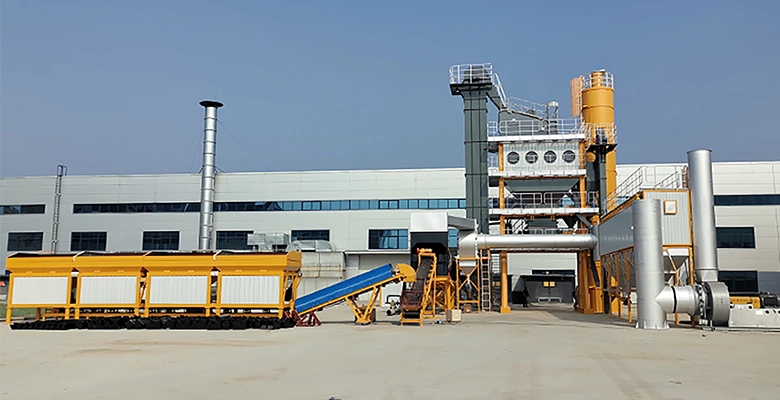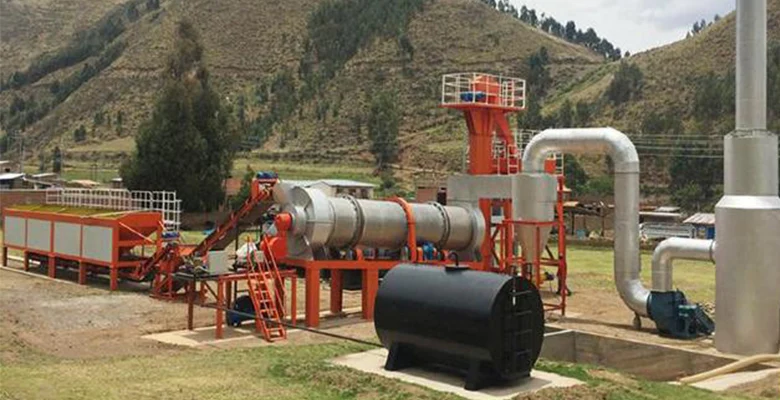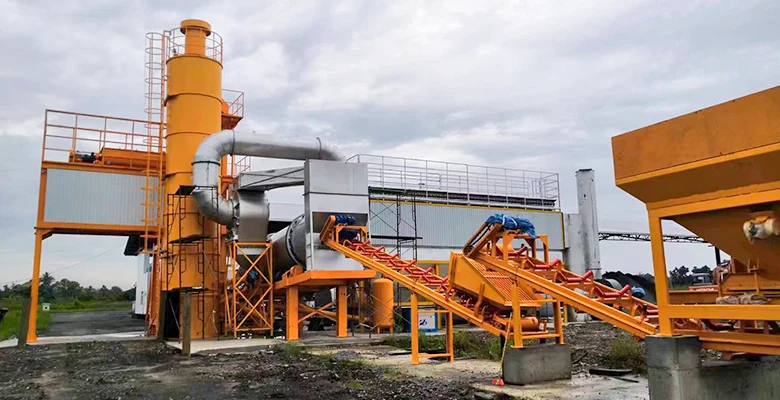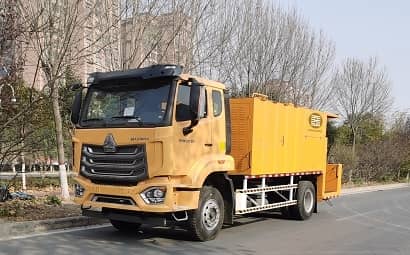Turning aggregates and bitumen into asphalt to build roads requires a thermal mixing process. An asphalt mixing plant is indispensable for this. The purpose of an asphalt mixing plant is to blend aggregate and asphalt together at an elevated temperature to produce a homogeneous asphalt paving mixture. The aggregate used can be a single material, a combination of coarse and fine aggregates, with or without mineral filler. The binder material used is normally asphalt but may be an asphalt emulsion or one of a variety of modified materials. Various additives, including liquid and powdered materials, can also be incorporated into the mixture.
There are three more popular types of hot asphalt mixing plants currently: batch mix, drum mix, and continuous drum mix. All three types serve the same ultimate purpose, and the asphalt mixture should be essentially similar regardless of the type of plant used to manufacture it. The three types of plants differ, however, in operation and flow of materials, as described in the following sections.
Batch Mix Asphalt Plant
asphalt mixing plant is key equipment for any road construction company. Any asphalt batch mix plant operation has many functions. Asphalt Batch plants produce hot mix asphalt in a series of batches. These batch mix plants produce hot mix asphalt in a continuous process. It is aslo possible to alter and use this equipment for production of hot mix asphalt using recycled material. Batch type plants have variations in them that allow addition of RAP (Reclaimed asphalt pavement). The components of a standard asphalt batch mix plant are: the coldfeed system, asphalt supply system, aggregate dryer, mixing tower, and emission-control system. The batch plant tower consists of a hot elevator, a screen deck, hot bins, a weigh hopper, an asphalt weigh bucket, and a pugmill. The aggregate used in the mix is removed from stockpiles and placed in individual cold-feed bins. Aggregates of different sizes are proportioned out of their bins by a combination of the size of the opening of the gate at the bottom of each bin and the speed of the conveyor belt under the bin. Generally, a feeder belt beneath each bin deposits the aggregate on a gathering conveyor located under all of the cold-feed bins. The aggregate is transported by the gathering conveyor and transferred to a charging conveyor. The material on the charging conveyor is then carried up to the aggregate dryer.

The dryer operates on a counter-flow basis. The aggregate is introduced into the dryer at the upper end and is moved down the drum by both the drum rotation (gravity flow) and the flight configuration inside the rotating dryer. The burner is located at the lower end of the dryer, and the exhaust gases from the combustion and drying process move toward the upper end of the dryer, against (counter to) the flow of the aggregate. As the aggregate is tumbled through the exhaust gases, the material is heated and dried. Moisture is removed and carried out of the dryer as part of the exhaust gas stream.
The hot, dry aggregate is then discharged from the dryer at the lower end. The hot aggregate is usually transported to the top of the plant mixing tower by a bucket elevator. Upon discharge from the elevator, the aggregate normally passes through a set of vibrating screens into, typically, one of four hot storage bins. The finest aggregate material goes directly through all the screens into the No. 1 hot bin; the coarser aggregate particles are separated by the
different-sized screens and deposited into one of the other hot bins. The separation of aggregate into the hot bins depends on the size of the openings in the screen that is used in the screen deck and the gradation of the aggregate in the cold-feed bins.
The heated, dried, and resized aggregate is held in the hot bins until being discharged from a gate at the bottom of each bin into a weigh hopper. The correct proportion of each aggregate is determined by weight.
At the same time that the aggregate is being proportioned and weighed, the asphalt is being pumped from its storage tank to a separate heated weigh bucket located on the tower just above the pugmill. The proper amount of material is weighed into the bucket and held until being emptied into the pugmill. The aggregate in the weigh hopper is emptied into a twin-shaft pugmill, and the different aggregate fractions are mixed together for a very short period of time— usually less than 5 seconds. After this brief dry-mix time, the asphalt from the weigh bucket is discharged.
into the pugmill, and the wet-mix time begins. The mixing time for blending of the asphalt with the aggregate should be no more than that needed to completely coat the aggregate particles with a thin film of the asphalt material—usually in the range of 25 to 35 seconds, with the lower end of this range being for a pugmill that is in good condition. The size of the batch mixed in the pugmill can be in the range of 1.81 to 5.44 tonnes (2 to 6 tons).
When mixing has been completed, the gates on the bottom of the pugmill are opened, and the mix is discharged into the haul vehicle or into a conveying device that carries the mix to a silo from which trucks will be loaded in batch fashion. For most batch plants, the time needed to open the pugmill gates and discharge the mix is approximately 5 to 7 seconds. The total mixing time (dry-mix time + wet-mix time + mix discharge time) for a batch can be as short as about 40 seconds, but typically, the total mixing time is about 45 seconds.
The plant is equipped with emission-control devices, comprising both primary and secondary collection systems. A dry collector or knockout box is normally used as the primary collector. Either a wet scrubber system or, more often, a dry fabric filter system (baghouse) can be used as the secondary collection system to remove particulate matter from the exhaust gases that flow out of the dryer and send clean air to the atmosphere through the stack.
If RAP is incorporated into the mix, it is placed in a separate cold-feed bin from which it is delivered to the plant. The RAP can be added to the new aggregate in one of three locations: the bottom of the hot elevator; the hot bins; or, most commonly, the weigh hopper. Heat transfer between the superheated new aggregate and the reclaimed material begins as soon as the two materials come in contact and continues during the mixing process in the pugmill.
Drum Mix Asphalt Plant
Comparing with batch type, drum mix asphalt plant has less thermal loss, lower working power, no overflow, less dust flying and stable temperature control. The control system automatically adjust asphalt flow rate according to the aggregates flow rate and pre-setting asphalt-aggregates ratio, to ensure precise proportional output. Asphalt drum mix plant is the types of plants that are categorized as continuous mixing plants, produce hot mix asphalt in a continuous process.

Typically the cold-feed systems on HMA batch and drum-mix plants are similar. Each consists of coldfeed bins, feeder conveyors, a gathering conveyor, and a charging conveyor. On most drum-mix plants and on some batch plants, a scalping screen is included in the system at some point. If RAP is also being fed into the plant to produce a recycled mix, an additional cold-feed bin or bins, feeder belt and/or gathering conveyor, scalping screen, and charging conveyor are necessary to handle the extra material. drum-mix plants consist of five major components: the cold-feed system, asphalt supply system, drum mixer, surge or storage silos, and emissioncontrol equipment.
The cold-feed bins are used to proportion the material to the plant. A variable-speed feeder belt is used under each bin. The amount of aggregate drawn from each bin can thus be controlled by both the size of the gate opening and the speed of the feeder belt to provide accurate delivery of the different-sized materials. The aggregate on each feeder belt is deposited onto a gathering conveyor that runs beneath all of the cold-feed bins. The combined material is normally passed through a scalping screen and then transferred to a charging conveyor for transport to the drum mixer.
The charging conveyor is equipped with two devices that are used to determine the amount of aggregate being delivered to the plant: a weigh bridge under the conveyor belt measures the weight of the aggregate passing over it, and a sensor determines the speed of the belt. These two values are used to compute the wet weight of aggregate, in tonnes (tons) per hour, entering the drum mixer. The plant computer, with the amount of moisture in the aggregate provided as an input value, converts the wet weight to dry weight in order to determine the correct amount of asphalt needed in the mix.
The conventional drum mixer is a parallel-flow system—the exhaust gases and the aggregate move in the same direction. The burner is located at the upper end (aggregate inlet end) of the drum. The aggregate enters the drum either from an inclined chute above the burner or on a Slinger conveyor under the burner. The aggregate is moved down the drum by a combination of gravity and the configuration of the flights located inside the drum. As it travels, the aggregate is heated and the moisture removed. A dense veil of aggregate is built up near the midpoint of the drum length to assist in the heat-transfer process.
If RAP is added to the new aggregate, it is deposited from its own cold-feed bin and gathering/charging conveyor system into an inlet located near the center of the drum length (split-feed system). In this process, the reclaimed material is protected from the high-temperature exhaust gases by the veil of new aggregate upstream of the RAP entry point. When mixes with high RAP content are used, it is more likely that the RAP will be overheated in the process. This may result in smoke being emitted from the drum or damage to the RAP.
The new aggregate and reclaimed material, if used, move together into the rear portion of the drum. The asphalt is pulled from the storage tank by a pump and fed through a meter, where the proper volume of asphalt is determined. The binder material is then delivered through a pipe into the rear of the mixing drum, where the asphalt is injected onto the aggregate. Coating of the aggregate occurs as the materials are tumbled together and moved to the discharge end of the drum. Mineral filler or baghouse fines, or both, are also added into the back of the drum, either just before or in conjunction with the addition of the asphalt.
The asphalt mix is deposited into a conveying device (a drag slat conveyor, belt conveyor, or bucket elevator) for transport to a storage silo. The silo converts the continuous flow of mix into a batch flow for discharge into the haul vehicle.
In general, the same type of emission-control equipment is used on the drum-mix plant as on the batch plant. A primary dry collector and either a wet scrubber system or a baghouse secondary collector can be used. If a wet scrubber system is used, the collected fines cannot be recycled back into the mix and are wasted; if a baghouse is used, the collected fines can be returned in whole or in part to the mixing drum, or they can be wasted.
Continuous Mix Asphalt Plant
In continuous plants there is no interruption in the production cycle as the rhythm of production is not broken into batches. The mixing of the material takes place inside the dryer drum which is elongated, as it dries and mixes the material at the same time. Since there are no mixing tower or elevators, the system is therefore considerably simplified, with a consequent reduction in the cost of maintenance. The absence of the screen however makes it necessary to have precise controls at the beginning of the production cycle, before the aggregates are fed into the dryer and before they are consequently discharged from the dryer as asphalt.

AGGREGATE METERING
Similar to batch asphalt mixing plants,
the production cycle of continuous plants aslo begins with the cold feeders, where the aggregates are generally metered by volume; if required, the sand extractor can be fitted with a weigh-belt for metering.
Control of the total weight of the virgin aggregates, however, is effected in two different phases of the production cycle in the two different plants. In the continuous type there is a feed belt, before the moist aggregates are fed into the dryer drum, where the moisture content is set manually in order to allow for the weight of water to be subtracted. Therefore it is extremely important for the moisture content in the aggregates, particularly the sand, to have a constant value which is continually monitored through frequent laboratory tests.
BITUMEN METERING
In continuous plants the bitumen metering is generally volumetric through a litre-counter subsequent to the feed pump. Alternatively, it is possible to install a mass counter, a necessary choice if modified bitumen is used, which requires frequent cleaning operations.
Filler metering
In continuous plants the metering system is normally volumetric, using variable-speed feed screws which have replaced the previous pneumatic metering system.
Control panel is PLC type in all our export plants. This is a huge value addition because we can customise PLC as per our requirement. The drum mixer that is equipped with a PLC panel is a different machine than a plant with microprocessor panel. PLC panel is also maintenance free compared to the microprocessor panel. We always believe in giving the best to customers so that they can stay ahead of their competition. Not all manufacturers and exporters of asphalt drum plants offer plant with PLC panel.
Pre testing of all the plants is done to ensure that anything that leaves our factory is ready to perform with less hassle at the site.
Sinoroader have more than 30 years of manufacturing experience and a product which is backed by professional service and cheaper spares so that you cherish and use your equipment for years to come.
 Albanian
Albanian  Russian
Russian  Arabic
Arabic  Amharic
Amharic  Azerbaijani
Azerbaijani  Irish
Irish  Estonian
Estonian  Odia (Oriya)
Odia (Oriya)  Basque
Basque  Belarusian
Belarusian  Bulgarian
Bulgarian  Icelandic
Icelandic  Polish
Polish  Bosnian
Bosnian  Persian
Persian  Afrikaans
Afrikaans  Tatar
Tatar  Danish
Danish  German
German  French
French  Filipino
Filipino  Finnish
Finnish  Frisian
Frisian  Khmer
Khmer  Georgian
Georgian  Gujarati
Gujarati  Kazakh
Kazakh  Haitian Creole
Haitian Creole  Korean
Korean  Hausa
Hausa  Dutch
Dutch  Kyrgyz
Kyrgyz  Galician
Galician  Catalan
Catalan  Czech
Czech  Kannada
Kannada  Corsican
Corsican  Croatian
Croatian  Kurdish (Kurmanji)
Kurdish (Kurmanji)  Latin
Latin  Latvian
Latvian  Lao
Lao  Lithuanian
Lithuanian  Luxembourgish
Luxembourgish  Kinyarwanda
Kinyarwanda  Romanian
Romanian  Malagasy
Malagasy  Maltese
Maltese  Marathi
Marathi  Malayalam
Malayalam  Malay
Malay  Macedonian
Macedonian  Maori
Maori  Mongolian
Mongolian  Bengali
Bengali  Myanmar (Burmese)
Myanmar (Burmese)  Hmong
Hmong  Xhosa
Xhosa  Zulu
Zulu  Nepali
Nepali  Norwegian
Norwegian  Punjabi
Punjabi  Portuguese
Portuguese  Pashto
Pashto  Chichewa
Chichewa  Japanese
Japanese  Swedish
Swedish  Samoan
Samoan  Serbian
Serbian  Sesotho
Sesotho  Sinhala
Sinhala  Esperanto
Esperanto  Slovak
Slovak  Slovenian
Slovenian  Swahili
Swahili  Scots Gaelic
Scots Gaelic  Cebuano
Cebuano  Somali
Somali  Tajik
Tajik  Telugu
Telugu  Tamil
Tamil  Thai
Thai  Turkish
Turkish  Turkmen
Turkmen  Welsh
Welsh  Uyghur
Uyghur  Urdu
Urdu  Ukrainian
Ukrainian  Uzbek
Uzbek  Spanish
Spanish  Hebrew
Hebrew  Greek
Greek  Hawaiian
Hawaiian  Sindhi
Sindhi  Hungarian
Hungarian  Shona
Shona  Armenian
Armenian  Igbo
Igbo  Italian
Italian  Yiddish
Yiddish  Hindi
Hindi  Sundanese
Sundanese  Indonesian
Indonesian  Javanese
Javanese  Yoruba
Yoruba  Vietnamese
Vietnamese  Hebrew
Hebrew  Chinese (Simplified)
Chinese (Simplified)








